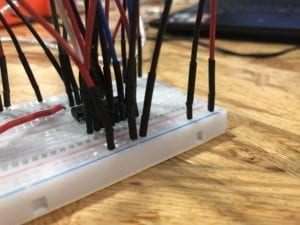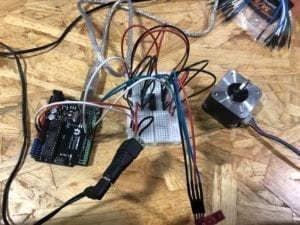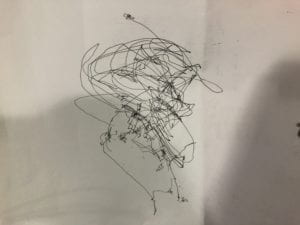Introduction:
In this recitation, first, I built a circuit to control the stepper motor and then add a potentiometer into the circuit individually. After I finished these steps, I paired up with a partner to build a drawing machine using two stepper motors.
Materials:
For Steps 1 and 2
1 * 42STH33-0404AC stepper motor
1 * L293D ic chip
1 * power jack
1 * 12 VDC power supply
1 * Arduino kit and its contents
For Step 3
2 * Laser-cut short arms
2 * Laser-cut long arms
1* Laser-cut motor holder
2 * 3D printed motor coupling
5 * Paper Fasteners
1 * Pen that fits the laser-cut mechanisms
Paper
Step 1: Build the circuit

I followed the given diagram to build a circuit that can control the stepper motor. After I finished building the circuit, I tried to connect my Arduino board to my computer. However, the Arduino board didn’t work, and it was heating. So I asked my instructor for help. At first, we both thought I fried my Arduino board and it cannot work again. But after we checked how I connected the circuit, we found that I put some wires in a wrong place. There were two wires that were supposed to be connected to the power, but I accidently connected them to the ground. That’s why my Arduino board isn’t working after connecting to the computer. When I fixed this problem, my Arduino started to work and the stepper motor rotated smoothly.
This is a picture of a wrong circuit.

These are some pictures and video of the working circuit.


Step 2: Control rotation with a potentiometer
In this step, I changed the circuit by adding a potentiometer into it so that I can control the rotation of the stepper motor. I also made a few changes to the code to fit the motor and to match the movement of the knob with the rotation of the motor.
Here is how I changed the circuit and how the circuit worked.


Step 3: Build a Drawing Machine!
After completing the steps above, I paired up with another classmate and built a drawing machine together. We used some Laser-cut arms, 3D printed motor coupling and paper fasteners to build the machine.
Let’s see how the machine works!

Question 1:
What kind of machines would you be interested in building? Add a reflection about the use of actuators, the digital manipulation of art, and the creative process to your blog post.
I think I would be interested in building the kind of machines that are very entertaining and artistic. I’m thinking of a keyboard whose shape is like a semi-disco ball and people can use it to play certain music games or make your own music. Unlike traditional keyboard, this one is based on ergonomics which allows people to use it for a long time without hands getting tired or stiff. Besides, functioning like the launchpad, people can use it to create or compose their own music as well. By creating different drumbeat and instrument sounds when pressing different buttons, people can produce various kinds of musical pieces. It can also be an art piece decorating your house because it has a very nice and unique appearance.
Question 2:
Choose an art installation mentioned in the reading ART + Science NOW, Stephen Wilson (Kinetics chapter). Post your thoughts about it and make a comparison with the work you did during this recitation. How do you think that the artist selected those specific actuators for his project?
I’m very interested in the project called Waves made by Daniel Palacios Jiménez in 2006. The way it interacts with people is through motion sensing. When there is no motion, the elastic rope stays still. When there is much motion, complex and chaotic patterns and sounds would show up. I think it represents people’s physical actions directly and dramatically. By presenting sounds and visual waves using the elastic rope, it shows a strong and close interaction with people around. Comparing this project with the drawing machine that I just built, they both use rotatable motors to realize the output. However, while the drawing machine responds to people rotating the potentiometer, Waves respond to people’s motion, which contains much more physical interactions than simply rotating something. The output of these two machines differ as well. The output of the drawing machine is the movements of its arms, or the painting eventually. The output of Waves is the sounds and movements of the rope. In terms of how the artist selected those specific actuators, I think it depends on the effects he wants to show and the sense organs that he wants to interact. For Waves, the artist chooses visual and auditory effects in order to exaggerate people’s motion. This kind of effect can be more directly perceived through the senses, thus it is clearer to the audience.